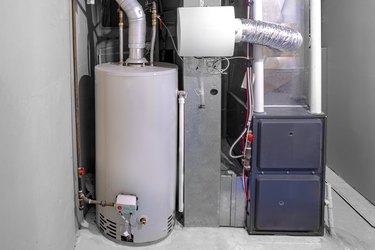
A drain seems like a strange thing to have on a furnace, but it really is a necessity for high-efficiency, or condensing, furnaces, and if it gets clogged, things could get messy in the furnace room. These furnaces need a drain because they produce water as a byproduct of combustion. During heating season, there's enough condensate to fill the drain pan under the furnace and spill over, and if you aren't a regular visitor to the furnace room, you may not find out about the problem until the floor is covered with water.
Where Does the Water Come From?
Video of the Day
What makes a furnace a high-efficiency furnace is the addition of a second heat exchanger that wrings the last bit of heat out of the gases emerging from the primary heat exchanger. It does this by circulating the gases in a series of small tubes, where they gradually cool down and condense into liquid form. Condensation is a process that releases heat, which gets circulated with the heat from the primary heat exchanger, raising the furnace's efficiency to as much as 97 percent.
Video of the Day
The condensates from the secondary heat exchanger drip into a pan underneath the furnace, and from there, a drain pipe carries them outside. This liquid is primarily carbonic acid, which is basically acidified water. In other words, it's corrosive and not something you want to have covering the furnace room floor, which is why you need to clear the drain pipe if it's blocked.
Will the Clog Do Any Damage?
Fortunately, the rim of the drain pan isn't physically connected to the furnace, and the pan isn't deep enough for water to rise to the level of the furnace. The worst that can happen is for the water to spill onto the floor, but that can cause big problems if you aren't in the habit of checking your furnace regularly. Damage to the flooring is one such problem that could be expensive to fix.
It's important to remember that where there is water, there is mold, especially in the warm climate of a furnace room. The furnace is sealed and gets its combustion air from outside, so there's little danger of the mold circulating through the house, but the furnace room will become dank and musty. Even if it doesn't get circulated by the furnace, the mold could spread to other rooms on ambient air currents.
How to Clear a Clogged Drain
The reason the drain is clogged is because sediment has collected in the pipe, and it may be at the drain inlet or outlet, so pushing in a piece of wire may break it up. You can also vacuum it from the outlet pipe using a strong wet/dry vacuum. You'll get more suction if you fit the vacuum hose over the pipe and seal the gap with duct tape. You may also have some luck poking a long wire into the pipe as if you were snaking a kitchen drain, but a furnace drain pipe is only 3/4 inch in diameter, and it often has many bends that prevent a wire from probing too deeply.
The most efficient way to clear a furnace drain is with a jet of water from a garden hose. If you can access the drain opening in the furnace drain pan, that's the best place to insert the hose, turn on the water full blast and blow out all the crud blocking the pipe.